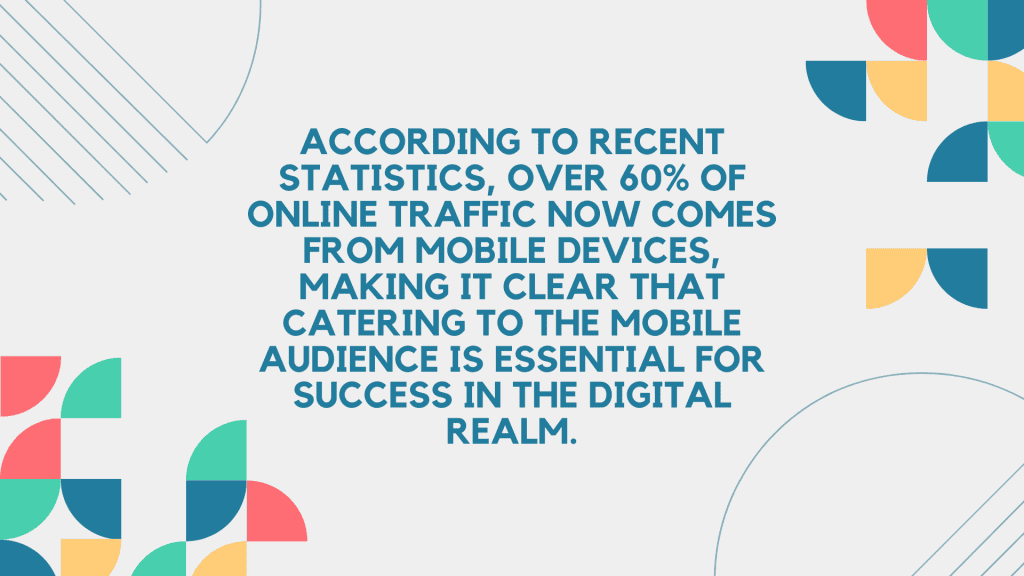In today’s digital landscape, where mobile devices dominate internet access, mobile optimization for content has become paramount. This article will delve into the importance of mobile optimization, backed by statistics showcasing the increasing use of mobile devices for online activities. We will also provide an overview of the topics covered in this blog, including mobile-friendly design, responsive web design, page speed, mobile SEO, AMP, and mobile content strategy.

In recent years, mobile optimization has evolved from being a nice-to-have to an absolute necessity. With the proliferation of smartphones and tablets, people are increasingly turning to mobile devices for accessing the internet. According to recent statistics, over 60% of online traffic now comes from mobile devices, making it clear that catering to the mobile audience is essential for success in the digital realm.
- Responsive Web Design: Creating a responsive design ensures that your website adapts seamlessly to different screen sizes and resolutions. This not only enhances the user experience but also aligns with Google’s mobile-first indexing, where mobile-friendly websites are prioritized in search results.
- Page Speed: Mobile users are typically on the go and have little patience for slow-loading websites. Page speed optimization is crucial to keep users engaged and satisfied. It’s also a ranking factor in Google’s algorithm, so it directly impacts your SEO performance.
- AMP (Accelerated Mobile Pages): Implementing AMP can significantly improve your mobile page speed. AMP pages are lightweight and load almost instantly, offering an excellent user experience. Google often displays AMP pages in search results, giving them a visibility boost.
- Mobile SEO: Mobile SEO goes beyond traditional SEO practices. It focuses on mobile-specific ranking factors, mobile user behavior analysis, and mobile content optimization. This ensures that your website performs well in mobile search results.
Mobile-first content optimisation prioritizes creating and delivering content tailored for seamless consumption on mobile devices. Recognizing the on-the-go nature of mobile audiences, it emphasizes concise, visually appealing, and easily navigable information. Prioritizing responsive design, quick load times, and engaging visuals ensures a user-friendly experience, catering to the fast-paced mobile environment. This approach enhances accessibility and user satisfaction, aligning content with the preferences and behaviors of today’s mobile-centric audiences.
Understanding Mobile-First Approach
In the fast-paced digital world, the mobile-first approach is not merely a buzzword; it’s a fundamental strategy for online success. This section will dissect the mobile-first approach, highlighting its significance and the critical role mobile optimization plays in engaging on-the-go audiences.
Mobile-First Approach Unveiled
The mobile-first approach is a web design and content strategy that prioritizes mobile devices over desktops when creating and optimizing websites. It acknowledges that more users are accessing the internet via mobile devices than ever before. Consequently, search engines like Google have shifted their focus towards mobile-first indexing.
The Significance of Mobile Optimization
Mobile optimization is the cornerstone of the mobile-first approach. It ensures that your website is user-friendly, loads quickly, and provides a seamless experience on mobile devices. Here’s why it’s essential:
1. Capturing the Mobile Audience
With the advent of smartphones, people are constantly on the move and seeking information while on the go. To reach this mobile audience effectively, your content must be easily accessible and readable on mobile devices. Mobile optimization makes this possible.
2. Enhancing User Experience
User experience is paramount in the digital realm. A mobile-friendly design and responsive web design are critical components of mobile optimization. They ensure that your website adapts flawlessly to various screen sizes, offering a smooth and enjoyable browsing experience.
3. Page Speed Matters
In the mobile-first era, slow-loading websites are a turn-off for users. Page speed optimization is not only about retaining visitors but also about SEO. Google favours fast-loading pages in its search rankings, making it a crucial element of mobile SEO.
4. The Power of AMP
AMP (Accelerated Mobile Pages) is a technology that can turbocharge your website’s mobile performance. AMP pages load almost instantly, significantly enhancing user experience and potentially boosting your search engine visibility.
5. Mobile-First Indexing
Google’s shift to mobile-first indexing means that it primarily uses the mobile version of a site for ranking and indexing. If your website is not mobile-optimized, it could suffer in search rankings.
Mobile-Friendly Design
In today’s digital landscape, where mobile devices are ubiquitous, having a mobile-friendly design is no longer optional—it’s a necessity. This section explores the critical role of responsive web design in optimizing for mobile devices, offers tips for creating visually appealing and user-friendly mobile layouts, and provides examples of websites that excel in mobile-friendly design.
Importance of Responsive Web Design
Responsive web design is at the core of mobile-friendly design. It ensures that websites adapt seamlessly to various screen sizes and resolutions, offering an optimal user experience across all devices. Here’s why it’s indispensable:
- User Experience (UX): Responsive design prioritizes user experience, making it easy for visitors to navigate and engage with your website, regardless of the device they use. This enhances mobile usability and keeps users on your site.
- Mobile SEO: Google rewards mobile-friendly websites with higher rankings in mobile search results. A responsive design aligns with mobile SEO best practices, positively impacting your search visibility.
- Page Speed: Mobile users expect fast-loading pages. Responsive designs are optimized for performance, contributing to quicker page speed and ensuring that visitors don’t abandon your site due to slow load times.
- Mobile-First Indexing: Google now primarily indexes the mobile version of websites. If your site lacks a mobile-friendly design, it may suffer in search rankings, affecting your mobile ranking.
Tips for Creating Mobile-Friendly Layouts
To excel in mobile-friendly design, consider the following tips:
- Keep it Simple: Simplify the mobile layout by prioritizing essential content and reducing clutter. Mobile content optimization ensures that the most critical information is readily accessible.
- Responsive Images: Optimize images for mobile devices to prevent slow loading times. Use responsive web design tips to ensure images scale appropriately.
- Mobile Navigation: Implement an intuitive and user-friendly navigation menu that’s easy to access and navigate on small screens. This enhances mobile user engagement.
- Font Size and Readability: Use legible fonts and maintain a readable font size. Visitors should not need to zoom in to read content, as this affects mobile content engagement.
Content Formatting for Mobile
In our mobile-centric world, effective content formatting for mobile is crucial for capturing the attention of on-the-go audiences. This section will delve into strategies for formatting text, images, and videos for mobile screens, emphasize the importance of concise and scannable content in mobile optimization, and provide best practices for optimizing headlines, subheadings, and bullet points.
Strategies for Mobile Content Formatting
- Text Formatting:
- Prioritize conciseness: Mobile users have limited attention spans. Keep your text concise and to the point, addressing the mobile user’s behaviour of seeking quick answers.
- Use subheadings: Break content into digestible sections with descriptive subheadings. This enhances scannability and aids users in finding relevant information.
- Utilize bullet points: Present information in bulleted lists for easy consumption. Mobile users appreciate information that’s presented straightforwardly.
- Image Optimization:
- Opt for responsive images: Ensure images scale appropriately to different screen sizes. This is a fundamental aspect of responsive web design.
- Use descriptive alt text: Mobile optimization also considers accessibility. Providing descriptive alt text for images benefits visually impaired users and improves mobile usability.
- Video Formatting:
- Implement responsive video players: Use video players that adapt to various screen sizes, ensuring a seamless viewing experience on mobile devices.
- Provide captions: Including captions or transcripts for videos enhances accessibility and allows users to engage with your content even in noisy or quiet environments.
The Role of Concise and Scannable Content
- Mobile user behaviour: Mobile users often skim content, looking for specific information. Well-structured content with clear headings and bullet points aligns with this behavior.
- User experience: Users value content that quickly delivers answers to their questions. Scannable content provides immediate value and enhances user experience.
- Mobile-friendly design: Effective content formatting is a component of mobile-friendly design, which caters to the preferences of on-the-go users.
Best Practices for Optimizing Headlines, Subheadings, and Bullet Points
- Headlines:
- Craft compelling and descriptive headlines that convey the main topic or benefit.
- Keep headlines concise and use relevant keywords, like ‘Mobile optimization for content.’
- Subheadings:
- Use subheadings to break down content into logical sections.
- Make subheadings informative and include keywords where appropriate.
- Bullet Points:
- Present key information as bullet points for easy consumption.
- Keep bullet points brief and use them to highlight essential details.
| Strategy | Importance |
| Text Formatting | Keeps content concise and scannable. |
| Image Optimization | Ensures images are responsive and accessible. |
| Video Formatting | Provides a seamless video experience on mobile. |
| Concise & Scannable | Aligns with mobile user behavior and enhances UX. |
| Headlines, Subheadings | Organizes content and boosts readability. |
| Bullet Points | Highlights key information for easy consumption. |
Page Load Speed
In the mobile-centric digital landscape, page load speed is a critical factor that significantly impacts mobile user experience. This section explores the profound effects of page load speed on mobile users, provides techniques to optimize website speed for mobile audiences, and offers valuable tools and resources for measuring and improving page load times.
The Impact of Page Load Speed on Mobile User Experience
- User Engagement: Mobile users expect instant gratification. Slow-loading pages can lead to high bounce rates, negatively affecting mobile user engagement. When pages load swiftly, users are more likely to stay and interact with your content.
- Conversion Rates: Page load speed influences conversion rates. Fast-loading pages facilitate smoother user journeys, making it easier for visitors to complete desired actions, such as purchases or sign-ups.
- Search Rankings: Google considers page speed as a ranking factor in its search algorithm. Slow-loading pages may lead to lower mobile ranking in search results, impacting your visibility to mobile users.
- User Satisfaction: Mobile users value a seamless experience. Rapid page load times contribute to user satisfaction and can enhance your reputation as a mobile-friendly website.
Techniques to Optimize Website Speed for Mobile Users
- Image Optimization: Compress and resize images for mobile screens, reducing file sizes without compromising quality. This is crucial for mobile-friendly design and improving page speed.
- Minimize HTTP Requests: Reduce the number of requests by combining multiple CSS and JavaScript files. This minimizes latency and speeds up loading times.
- Leverage Browser Caching: Enable browser caching to store website data locally on users’ devices. Cached resources load faster upon return visits, enhancing mobile performance.
- Content Delivery Networks (CDNs): Utilize CDNs to distribute website content across multiple servers worldwide. This reduces server response times and improves mobile user behaviour.
- AMP (Accelerated Mobile Pages): Implement AMP to create lightning-fast mobile pages optimized for mobile-first indexing. AMP is an effective mobile SEO strategy.
- Reduce Server Response Time: Optimize server performance to ensure rapid response times to user requests, minimizing waiting times.
Conclusion
- Mobile-First is the Future: The mobile audience is growing rapidly, and users are increasingly on the go. Adopting a mobile-first approach ensures your content reaches this expanding audience effectively.
- User Experience Matters: Mobile optimization is all about delivering an exceptional user experience on smartphones and tablets. This involves responsive design, fast page load speed, and content that’s easy to consume on small screens.
- Speed is Crucial: Page load speed significantly impacts user engagement, search rankings, and conversion rates. Optimizing page speed for mobile users is non-negotiable.
- AMP Accelerates Performance: Consider implementing AMP (Accelerated Mobile Pages) to create lightning-fast mobile pages. AMP aligns with Google’s mobile-first indexing, improving your site’s visibility in mobile search results.
- Mobile SEO is Vital: Mobile optimization goes hand in hand with mobile SEO techniques. It’s essential for climbing the mobile search rankings and staying competitive.
- Content Strategy is Key: Develop a comprehensive mobile content strategy that caters to the unique preferences and behaviours of mobile users. This includes concise and scannable content, engaging visuals, and mobile-friendly formats.
FAQs
What are the best practices for mobile optimization?
Best practices for mobile optimization include using responsive web design, optimizing images and media, enabling browser caching, reducing server response time, using mobile-friendly fonts and layouts, and minimizing unnecessary pop-ups or interstitials. Ensure fast load times and a seamless user experience on mobile devices.
How can I improve the mobile user experience on my website?
To improve mobile user experience, prioritize responsive design, optimize for touchscreens, simplify navigation, use legible fonts and readable text sizes, reduce page load times, avoid intrusive ads, and conduct user testing for feedback. Ensure content is easily accessible and the site is mobile-friendly.
What are some mobile SEO techniques?
Mobile SEO techniques include optimizing for mobile-friendly design, using responsive web design, improving page speed, leveraging AMP (Accelerated Mobile Pages), optimizing images and videos, implementing schema markup, and focusing on local SEO for mobile users.
What is the importance of responsive web design for mobile optimization?
Responsive web design ensures that your website adapts to various screen sizes and devices, providing a consistent and user-friendly experience. It’s crucial for mobile optimization because it helps improve usability, SEO rankings, and user satisfaction on smartphones and tablets.
How can I boost mobile page speed?
Boost mobile page speed by optimizing images, using browser caching, minimizing HTTP requests, reducing server response times, enabling compression, and employing content delivery networks (CDNs). Prioritize lightweight design and efficient coding for faster loading.
What strategies can I use for mobile-first indexing?
Strategies for mobile-first indexing include ensuring mobile content matches desktop content, optimizing for mobile speed, using responsive design, and ensuring mobile SEO best practices like structured data and mobile-friendly layout.
What are the key factors for mobile content performance?
Key factors for mobile content performance include fast loading times, mobile-friendly design, concise and engaging content, easy navigation, optimization for touchscreens, and compatibility with various mobile devices and screen sizes.
How do I implement AMP on my website?
To implement AMP (Accelerated Mobile Pages), create AMP versions of your web pages, use AMP HTML and JavaScript components, and add the necessary tags and metadata. Validate your AMP pages and submit them to Google for indexing.
Can you provide insights on mobile user behavior?
Mobile user behavior includes shorter attention spans, on-the-go searching, local searches, and high bounce rates for slow-loading pages. Users often engage with mobile apps and expect seamless, responsive, and visually appealing experiences.
What should be on my mobile SEO checklist?
Your mobile SEO checklist should include mobile-friendly design, fast loading times, mobile-friendly content, responsive design, local SEO optimization, structured data markup, and usability testing on mobile devices.
What strategies can help me optimize for mobile search?
Optimize for mobile search by prioritizing mobile-friendly design, improving page speed, using mobile SEO best practices, focusing on local SEO, and creating high-quality, engaging mobile content.
How can I improve mobile content engagement?
Improve mobile content engagement by creating concise, scannable content, using visuals and multimedia, optimizing for mobile speed, encouraging social sharing, and providing clear calls-to-action (CTAs) that are easy to tap.
What are the latest mobile SEO trends in 2023?
In 2023, mobile SEO trends may include the continued emphasis on page speed, core web vitals, mobile-first indexing, voice search optimization, local SEO for mobile, and the impact of emerging technologies like 5G and mobile AI.
What are the ranking factors for mobile content?
Mobile content ranking factors include mobile-friendliness, page speed, content quality and relevance, mobile usability, structured data markup, local SEO signals, and user engagement metrics like click-through rates and dwell time.
What tools are available for mobile content optimization?
Tools for mobile content optimization include Google’s Mobile-Friendly Test, PageSpeed Insights, Google Search Console’s Mobile Usability report, mobile SEO plugins for content management systems (e.g., Yoast SEO), and various mobile performance testing tools.
Can you share some mobile SEO case studies?
I don’t have access to real-time data or specific case studies, but you can find mobile SEO case studies and success stories from reputable sources like SEO blogs, industry publications, and digital marketing agencies’ websites for valuable insights and examples of effective mobile optimization strategies.






